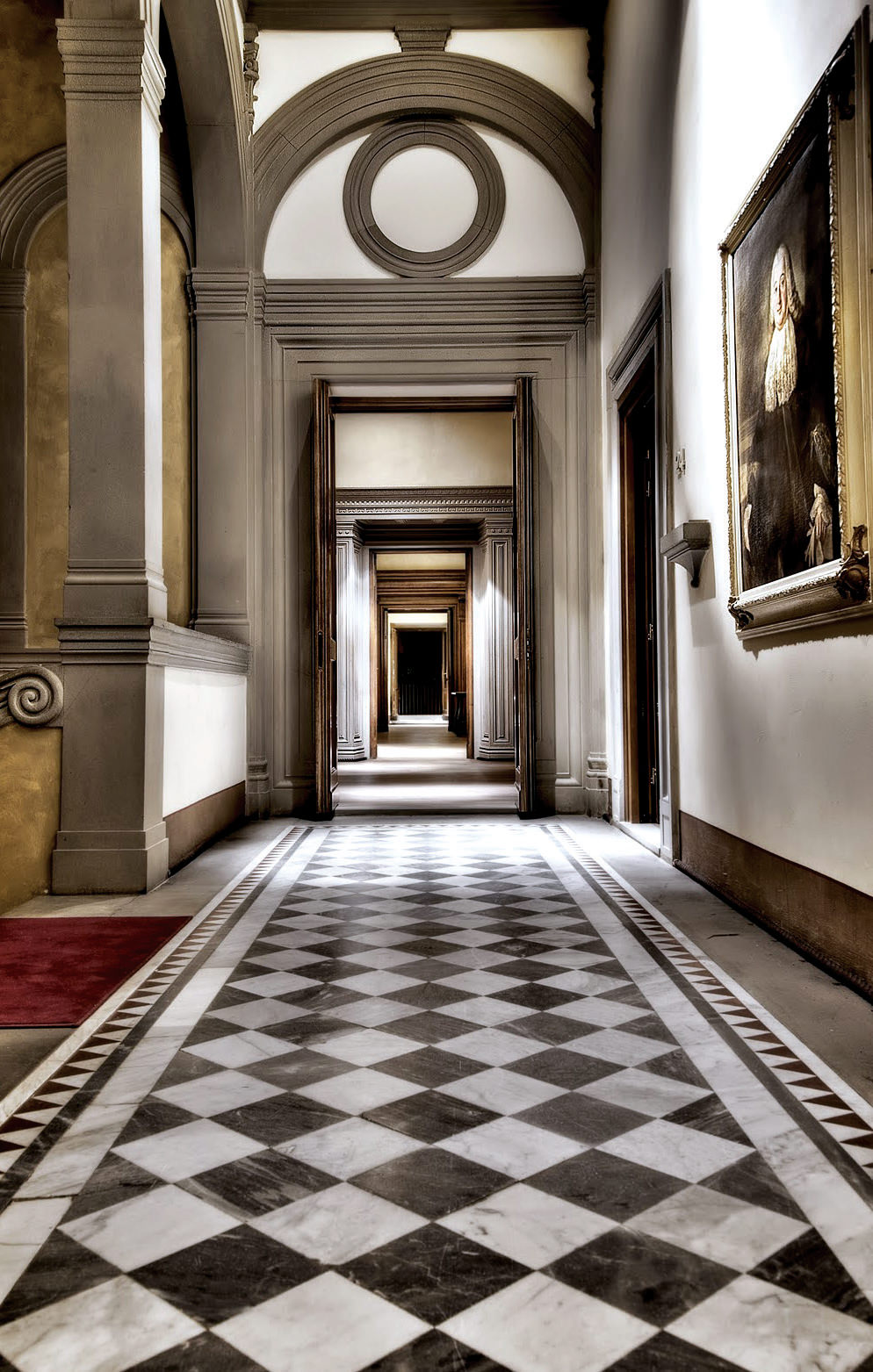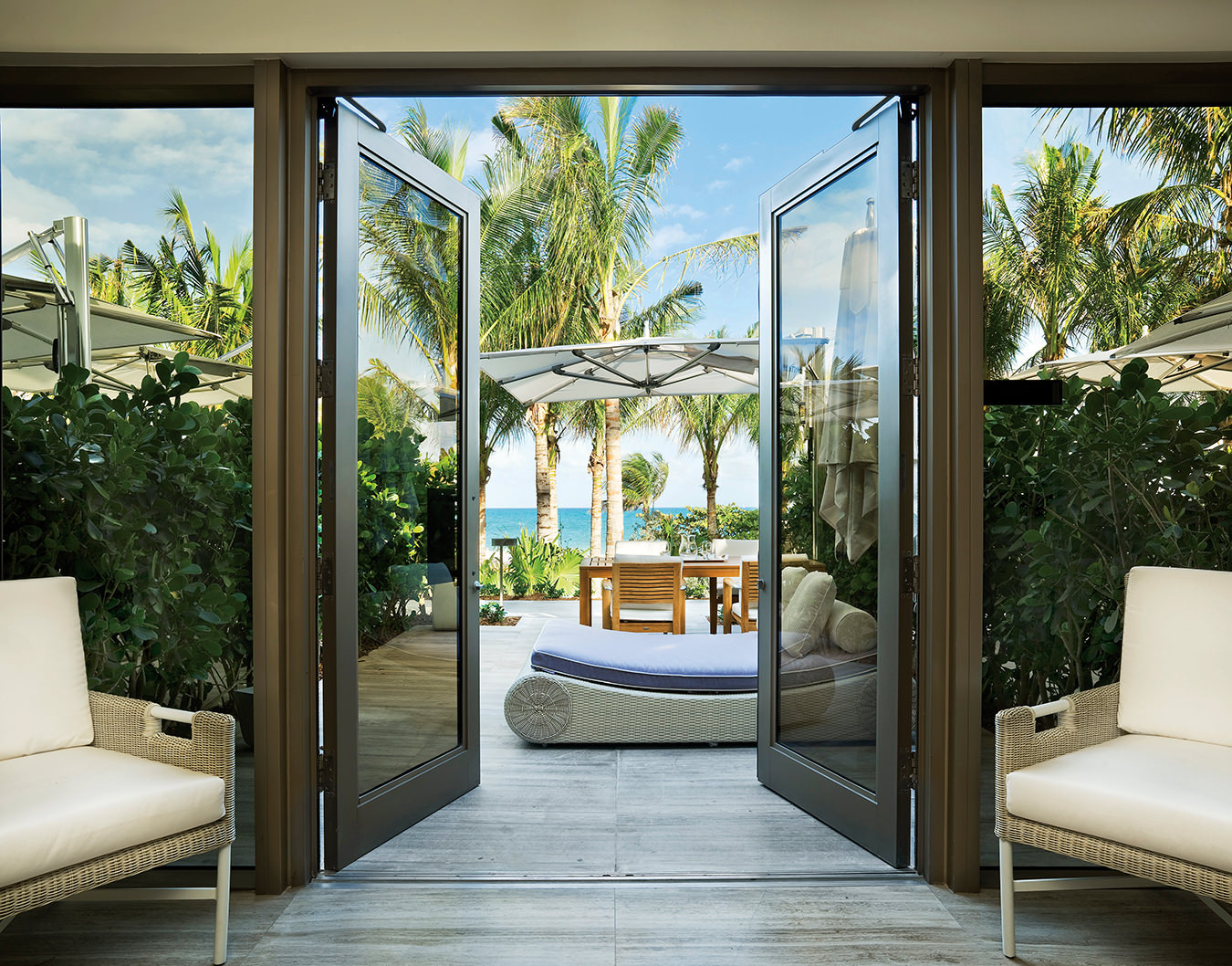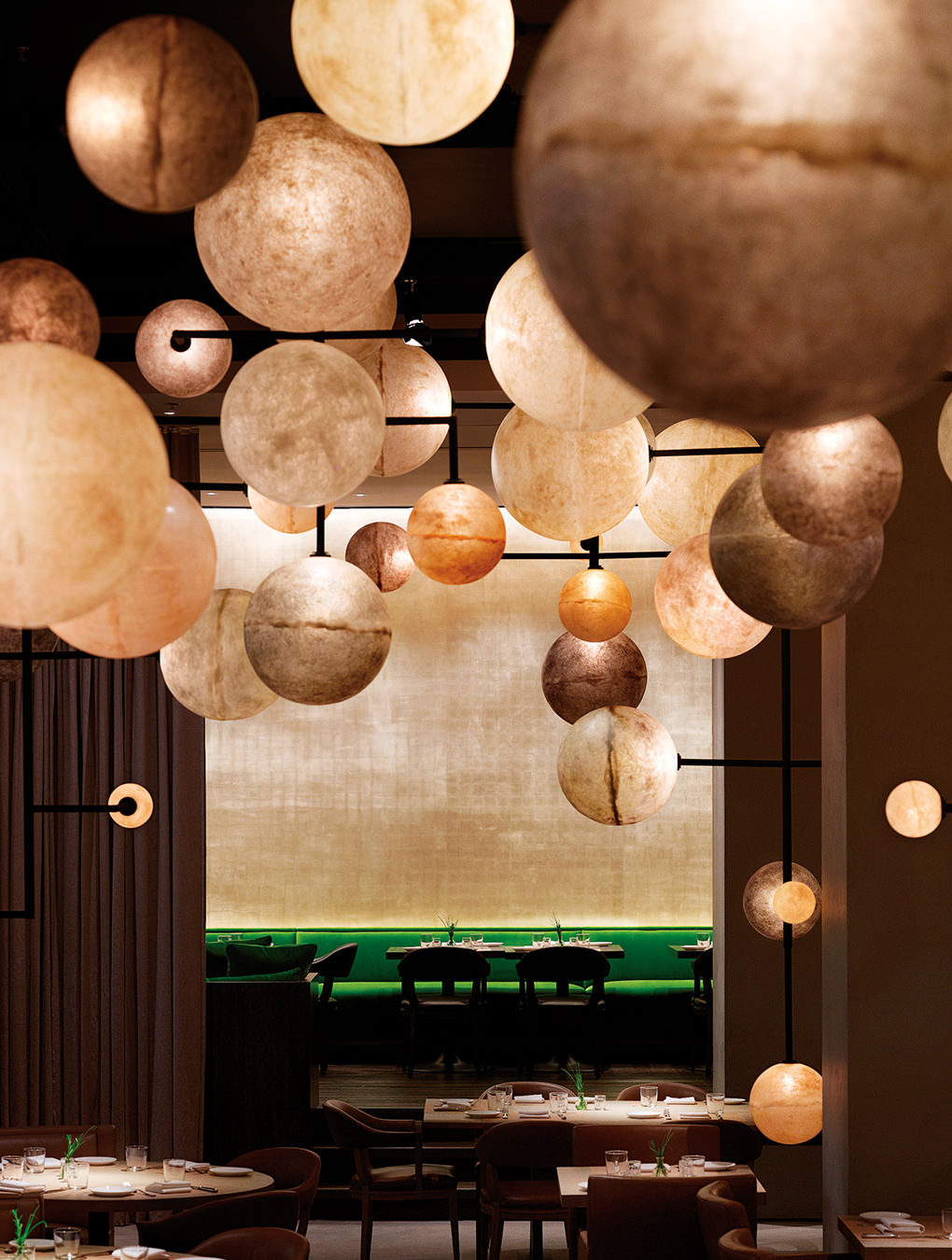Framing Sicily
The definitive collection of Italian villas.
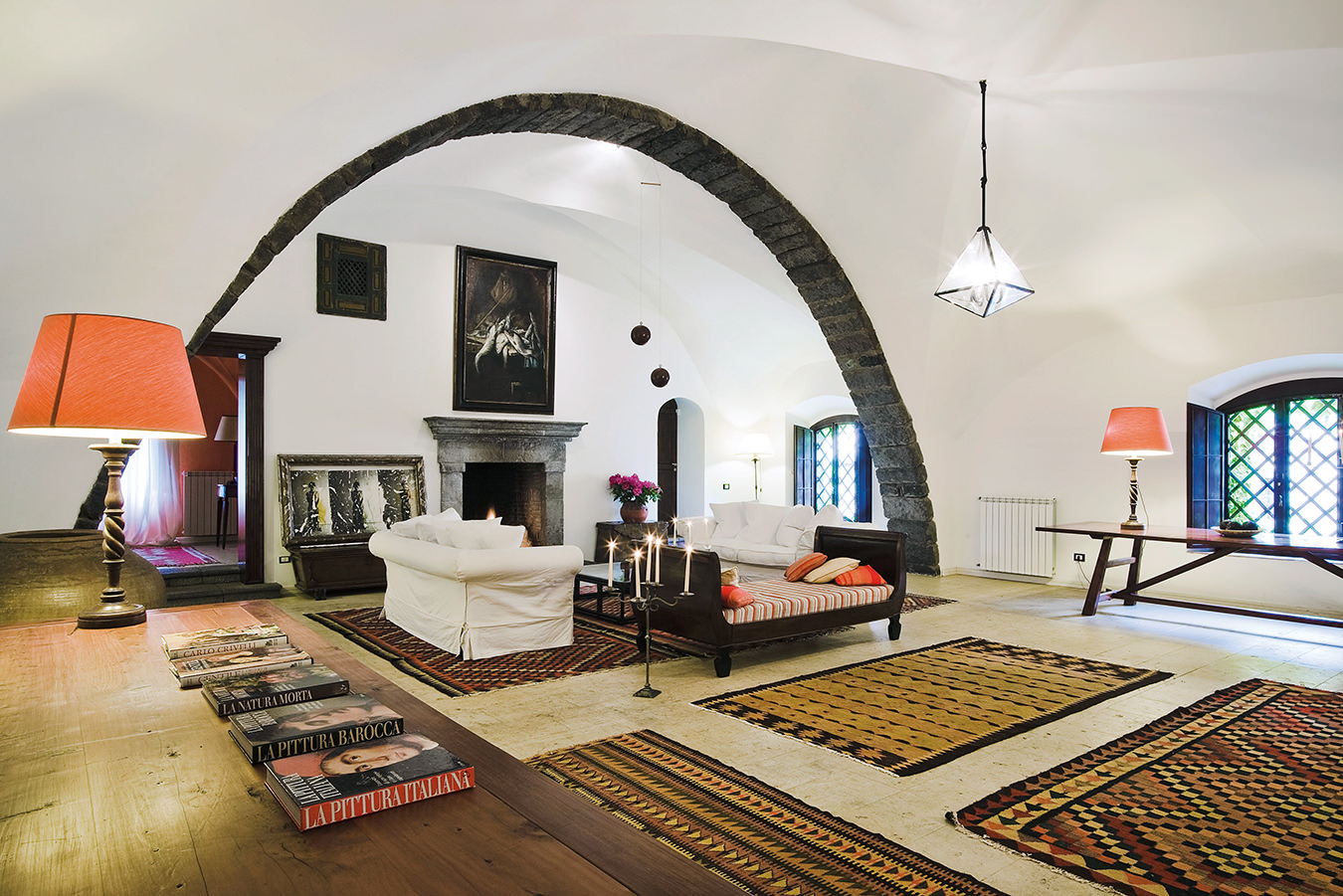
Don Arcangelo all’Olmo is often cited as one of the best places to stay in Sicily. One of the living rooms.
On the horizon, the brilliant blue sky, freckled with pillows of white, meets the turquoise waters of the Ionian Sea. A sprightly bird flits across manicured gardens to a crystal clear swimming pool. Olive trees, centuries old, tower in well-groomed patterns. A lizard crawls into a small alcove beneath the stone wall that meanders across a verdant lawn. The smell of lemon groves wafts across the surrounding estate. I am taking it all in on the balustrade terrace of this 18th-century villa, enjoying the solitude, the colours, and the atmosphere particular to this dramatic Italian island. I think I’m dreaming, until I hear the church bells toll.
A long list of admirers have made their way to Sicily’s sunny shores. The earliest waves of ragged visitors boated from Italy’s boot across the 4.8-kilometre stretch of the Strait of Messina, children and meagre possessions in tow; that was in approximately 20,000 BC, or so scholars claim. Other invaders followed; many were eager to protect their lucrative sea routes, some wished to expand their empires, and others fled from conflicts farther north. Mount Etna, Europe’s highest volcano, often served as a landmark for these lost souls. But that was long ago; today, a different agenda awaits.
I’m staying at Don Arcangelo all’Olmo, a 12-bedroom palazzo of aristocratic seclusion on the island’s east coast, located midway between Catania and Taormina. The chestnut-brown portone with its unassuming double doors are in no way indicative of what lies behind. Crossing the threshold brings me into an embarrassment of beauty; with such sights, smells, and sounds, it would be difficult to ask for a more immersive setting. There is no front desk, no registration papers; instead, the house staff are in attendance in the grand entranceway, and greet with a heartfelt “Buongiorno.”
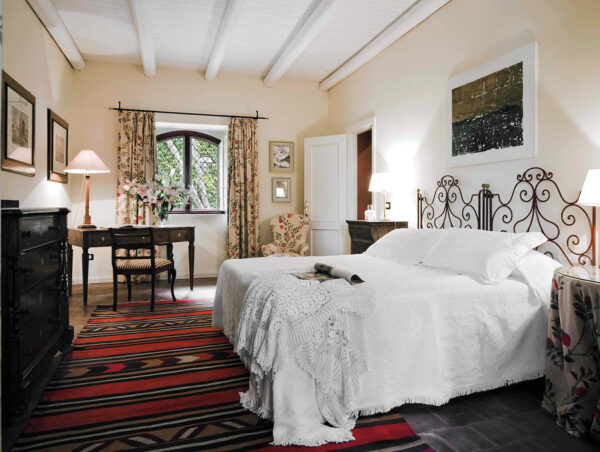
One of the villa’s bedrooms.
Some of Sicily’s noblest families have opened their homes for visitors to luxuriate in, resulting in a collective of the most desirable villas of the region available, exclusively, through boutique rental agency Think Sicily. The properties range in style, size, location, and genre—from seafront/coastal to romantic/honeymoon, from best in luxury to more family oriented. To capture Sicily’s unique spirit, you need to go beyond the package destinations. Taormina, for example, is stunningly beautiful and home to the magnificent Teatro Greco, which looks down onto the Bay of Naxo, and yet the town is a victim of its own success, overrun by mobs of tourists. To capture Sicily’s unique soul, you need to go beyond hotel lodging.
To capture Sicily’s unique spirit, you need to go beyond the package destinations. Don Arcangelo All’Olmo stirs plenty of emotions; it draws you in and invites you to get lost.
Sicilian-born Rossella Beaugié and her British husband, Huw, set up Think Sicily in 2002. They have explored every corner of the island, and they started the agency to share their knowledge with other travellers. Their expertise and devotion has allowed Think Sicily to acquire a roster of 94 properties and a reputation as the leading rental agency when it comes to accommodations on the island. The Think Sicily consiglieri are there to help, functioning less like real estate agents than travel concierges. They are generous with their knowledge of island lore, and no request is too large or small; they have not just a mission but a passion to ensure all your requests are met.
At Don Arcangelo all’Olmo, the lady of the house, Donna Marina, approaches me and welcomes me. She is regal and confident, but not intimidating. She exudes the warmth of the Sicilian sun, and her laugh is alluring. “Marina,” she insists, when I greet her with “Signora.”
Don Arcangelo all’Olmo is often cited as one of the best places to stay in Sicily, and it has been in Marina’s family for centuries. It dates back to the early 1700s, when it was one of several farm buildings on a wine-producing estate. At the beginning of the 19th century, it became home to the vineyard’s winery and, as such, was filled to the ceiling with aging wine. Only 40 years ago did the vines give way for fragrant citrus groves. Don Arcangelo all’Olmo opened its doors to its first house guest in 2003, fashion photographer royal Paolo Roversi. Plenty of VIPs have stayed at Don Arcangelo all’Olmo, but that is inconsequential. Everyone who stays here is treated like royalty, no matter your lineage.
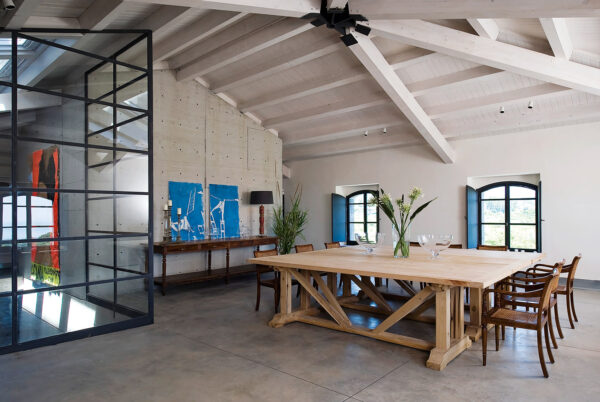
The dining room at Rocca delle Tre Contrade.
To call the villa majestic barely constitutes a just description at all. Lava rock, terracotta, limestone, and marble are all in abundance. Arched ceilings and grand rooms, regal textiles and tapestries, fine furniture and an array of artifacts, each with a story to tell, collectively make up this museum of life. These diptychs add flavour and abundance to the property. All bedrooms are bright and homey; in one of them, a framed photo of Marina gives some insight that she may have been a model in her formative years—her tar-black, waist-length hair and beauty endure.
A full-time staff is on hand at Don Arcangelo all’Olmo. Graziella, the resident cook of 10 years, prepares meals to order each day, using market-fresh ingredients. Be prepared to eat well. The fisherman visits casa Olmo (as did the baker in decades of old), with his panchetta of morning-caught pesce from which Graziella selects the desired fish—oh, the acciughe. The cakes are made daily in the early morning hours before sunrise; the fruit, in season and in abundance, plated decoratively; the arancini and fiori di zucchine are fried only minutes before they are served. From a traditional Sicilian meal of pasta incrostata to an eight-course banquet, dinners are always family style and plated with white-glove service. Dine on the wisteria-covered terrace or, on those cool nights, indoors at the stately dining table with adornments including avocado vines, hibiscus, or bougainvillea as a table runner, and candelabras for mood lighting. There is no gilded gold or filigreed silver. There doesn’t need to be. The elegance is in the simplicity.
I can’t help but think of scenes from Cinema Paradiso, when villagers crowd into a theatre, getting lost in the movie together. A great scene stirs the heart like a great line in a novel. Don Arcangelo all’Olmo stirs plenty of emotions; it draws you in and invites you to get lost.
Italy has long provided an unequalled backdrop for memorable films and novels, with the art and culture of cities like Florence and Rome, the laghi (lakes) of the north, the Tuscan countryside, and the splendours of Venice. The enormous variety of landscapes, towns, and sea views that Sicily boasts (not to mention its most notorious export—the Mafia) has made it a particular favourite. This lush and once prosperous island, the largest in the Mediterranean Sea, is a marvel. Along with being famed for its superlative cuisine, dramatically perched clifftop villages, and ancient temples, the island has endless stretches of beautiful beaches.

The imposing Rocca delle Tre Contrade villa.
The newest addition to the Think Sicily portfolio is Rocca delle Tre Contrade, overlooking expansive views of the sea and the massif of Mount Etna. The villa was an aristocratic estate, believed to be built in the 1850s. When Jon Moslet, one of the three current owners, saw the property in 2004, “it was a ruin,” he says. “There was no roof, and trees were growing in the place.” With a bit of craziness, a lot of optimism, and the purchase price of “a one-bedroom flat in Milan,” Moslet and team set to rescue the abode.
Moslet, originally from Norway, faced a lot of mistrust from the outset (even though one of the three investors is from Catania). “Sicilians are suspicious,” he says, “And after so many invasions, suspiciousness may be a part of their blood.” Previously, Moslet was a wine distributor in Scandinavia specializing in Sicilian wines; he’d spent years in the province and couldn’t help but notice the plethora of abandoned buildings. He saw the potential. And, “I quite enjoy the chaos,” he says about the way of life in Sicily that gives magnificence to it all.
“Sicilians don’t work outside when it rains,” he says with a chuckle. It is an unwritten code: “If it rains, you don’t show up.” And rain wasn’t the only factor in delays. As with most restoration projects, time and money surpassed schedules and budgets. But now, nine years later, Rocca delle Tre Contrade is a contemporary revival, harmoniously mixing the villa’s original details—lofty lava-stone arches, vaulted ceilings, terracotta floors—with Scandinavian design influences, an ode to Moslet’s roots. Sicily is a land of contrasts, and Rocca delle Tre Contrade the basilica of Nordic-Sicilian.

The infinity pool that overlooks a lemon grove.
The villa can accommodate up to 22 guests in its 11 bedrooms with ensuite bathrooms. Nearly all of the bathrooms have views of the sea, with some housing private balconies. The decor seamlessly mixes modernist with relic, and the full-featured kitchen is a magnet. Cook-in-residence Antonella prepares meals so gratifying that you will be asking for seconds. An infinity pool, perhaps the most spectacular in all of Sicily, overlooks a lemon grove; a stone bridge leads to Santa Venerina, the nearby town; the dining table seats 32. There is an emotional coherence in the space—the hardware meets the software. Rocca delle Tre Contrade is straight out of an interior design magazine, and the property has already received accolades from Italian architecture competition Premio Internazionale Ischia di Architettura (PIDA). “I can’t really relax when I’m here,” says Moslet (perhaps not surprisingly, since the completion, in late 2012, of the project is still so raw), “and so when someone comes here and compliments [the villa], it’s a satisfaction.” Moslet is modest about masterminding such an extensive project, but there are moments when you see the pride. His eyes say it all.
Approaching Rocca delle Tre Contrade at nightfall is a scene to be remembered. The master of the house descends the gradient cobble walkway with a towering lantern.
The first impression of approaching Rocca delle Tre Contrade at nightfall is a scene to be remembered. The master of the house descends the gradient cobble walkway with a towering lantern. By the light of the burning candle, Moslet leads the way to this villa of splendour.
Mount Etna is a short distance from Rocca delle Tre Contrade. A visit to the volcano is worth doing properly; it’s easy to ride the cable car up to the 3,000-metre mark and take some high-altitude photos, but without the services of a geologist like Roberto Caudullo of Volcano Trek, specializing in volcano excursions, the lava fields, craters, and fumaroles remain a mystery.
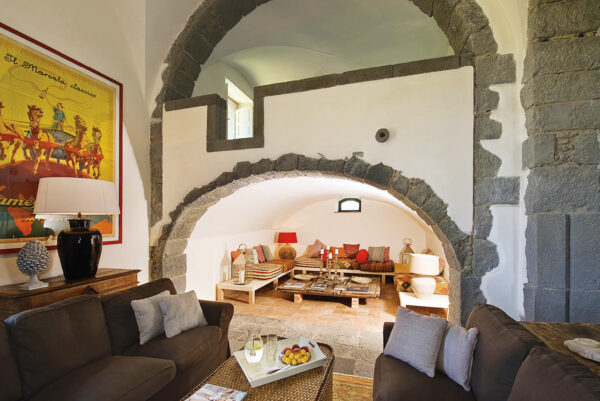
The villa of Rocca delle Tre Contrade is a basilica of Nordic-Sicilian design.
Sicily’s culture has been subject to waves of external influences. The island was colonized by the Greeks and Romans, later invaded by the Vandals, Arabs, Normans, and various Italian dynasties. It stands proudly separate from the rest of Italy, which locals refer to as il continente—the continent. The southern tip of the island boasts magnificent baroque architecture, epitomized in the town of Noto. Designated a UNESCO World Heritage site, Noto was rebuilt in flamboyant style following the great earthquake in 1693. A stroll down Corso Vittorio Emanuele, the main thoroughfare, is like walking through the set of a play from the 18th century.
Cubo al Mare (“cube by the sea”) is a contemporary villa on the coastline of the Lido di Noto. This white cube, aptly named, is awash with light and space, and sits in a lawned garden, the property perimeter lined with 1,000 distinctive cipressi trees. The villa is an expression of Sergio Mazzara, a 30-something patrician whose family is one of the largest organic lemon producers. Mazzara left Sicily to pursue a degree in law and returned to the island five years ago. “I just sell lemons,” says the jocular Mazzara. That is, indeed, his day job as a third generation cultivatore, but as design and architecture are two great pulls for Mazzara, Cubo al Mare is a personal project.
This villa is a two-storey structure, all straight lines save a curvaceous Gehry-esque flight of stairs. Natural oak hardwood dominates throughout, and all bedrooms boast sea views with expansive windows. There are no wall furnishings—instead, the bold, white-framed cantilevered windows are the mise en scène. “When I go inside a modern museum, I feel good,” says the proud Sicilian. “I lose myself in the MOMA.” There is no question that Mazzara intends for guests at Cubo al Mare to lose themselves in this modern gallery-space villa. “It was important for me to make something for beauty not money,” he says. Style does not dominate substance: this is a house designed to be lived in.
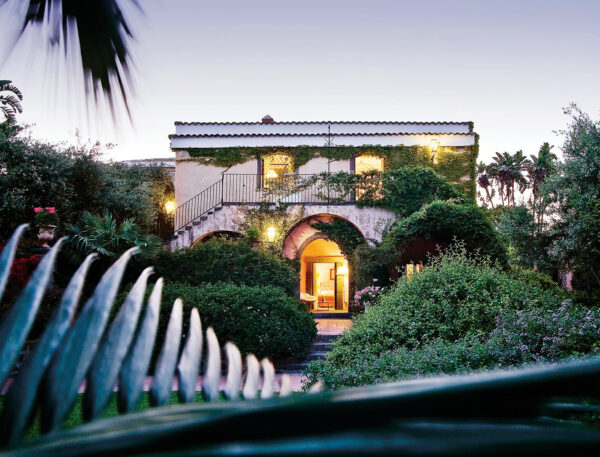
Don Arcangelo all’Olmo at nightfall.
You would be remiss to stay at Cubo al Mare and not indulge in a Sicilian original, a centuries-old icy delicacy: granita. Mazzara will keep your lemon supply well stocked, and as Sicilian lemons are a less acidic, more floral variety, savouring Mazzara’s granita al limone (his nonna’s recipe) will be a daily routine. Not all granita is made equal. There are different styles—more or less granular, more or less slushy—that depend on location and whim, but most experts agree that granita is at its best on the eastern part of the island. Staying at Cubo al Mare—you can’t get any farther east. Granita al limone at Cubo al Mare is conclusive—you won’t have better.
Travel piques our sense of wonder, satisfies our curiosities, and instills in us an appreciation for the diverse cultures and landscapes of each destination visited. As much as you will have the urge to get out and see Sicily, you will doubtlessly discover that you’re happiest while staying in the villa. Oversleep, underplan. Live like someone lived before.
Be sure to listen to the silence of these places; these are walls that tell stories. Traces of the past linger. This is not the present made up to be the past, but a past authentically here in the present. Inside each borrowed villa, you will find truth, as history has not been supplanted by novelty. Each of Don Arcangelo all’Olmo, Rocca delle Tre Contrade, and Cubo al Mare is a representation of some part of the Sicilian culture. Think Sicily frames it for you—94 distinct views.
Photos courtesy of Think Sicily.


